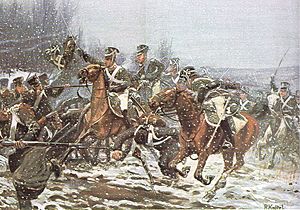Battle of La Rothière facts for kids
Quick facts for kids Battle of La Rothière |
|||||||
|---|---|---|---|---|---|---|---|
| Part of the Campaign of France of the Sixth Coalition | |||||||
 Württemberg dragoons charging French infantry |
|||||||
|
|||||||
| Belligerents | |||||||
|
|||||||
| Commanders and leaders | |||||||
| Strength | |||||||
| 41,000-45,000 128 guns |
110,000-123,000 | ||||||
| Casualties and losses | |||||||
| 3,000-4,600 killed or wounded 1,000 captured 73 guns lost |
6,000–7,000 killed or wounded | ||||||
The Battle of La Rothière was a big fight that happened on February 1, 1814. It was part of the Napoleonic Wars, a time when Emperor Napoleon of France was fighting against many other European countries. This battle took place in a small French town called La Rothière.
Napoleon's army, the French Empire, fought against a large group of allied armies. These allies included soldiers from Austria, Prussia, Russia, and other German States. The allied forces were led by a Prussian general named Gebhard Leberecht von Blücher.
The weather during the battle was terrible, with a heavy snowstorm. This made fighting very difficult for both sides. Even though the French army was defeated, they managed to retreat safely under the cover of darkness.
Contents
Leading Up to the Battle
How the Armies Met
In January 1814, General Blücher's army moved quickly into France. They were trying to meet up with other allied forces. On January 28, Blücher's advanced troops connected with the Austrian army near La Rothière.
Napoleon's Surprise Attack
On January 29, Napoleon launched a surprise attack on the Prussians. Blücher's headquarters were almost captured. He quickly realized that Emperor Napoleon himself was leading the French troops.
Allies Prepare for Battle
Because of Napoleon's attack, Blücher's army had to fall back a few miles. They took a strong position that protected the roads leading out of the Bar-sur-Aube area. The Austrian army then joined the Prussians. They decided to fight because the roads behind them were so full of troops and supplies that they couldn't retreat easily.
Who Fought in the Battle?
French Army Details
Napoleon's French army had about 45,000 soldiers. They were organized into 57 groups of foot soldiers (battalions) and 62 groups of horse soldiers (squadrons). They also had 128 cannons. The special Imperial Guard was led by General Philibert Jean-Baptiste Curial. Other important French leaders included Marshal Claude Victor-Perrin and General Emmanuel Grouchy, who led the cavalry (horse soldiers).
Allied Forces Details
The allied army was much larger, with about 110,000 to 123,000 soldiers. This army was made up of soldiers from many different countries.
- Prince Scherbatov led the Russian 6th Corps.
- General Zakhar Dmitrievich Olsufiev led the Russian 9th Corps.
- Count Liewen III commanded the Russian 11th Corps.
- General Ignaz Gyulai led the Austrian 3rd Corps.
- Crown Prince Frederick William of Württemberg led the 4th Corps.
- General Karl Philipp von Wrede commanded the Austro-Bavarian 5th Corps.
There were also several other groups of horse soldiers. To tell their friends from their enemies, the allied soldiers wore white bands on their shoulders.
The Battle Itself
Fighting in the Snowstorm
The battle began around noon on February 1. Napoleon's army attacked, but the weather was terrible. The ground was very muddy and soft because of the snow. This made it hard for Napoleon's cannons to move and fire effectively.
During the battle, heavy snowstorms would sweep across the field. This made it difficult for soldiers to see where they were going. French groups of soldiers sometimes lost their way. Many were also attacked by Cossacks, who were skilled Russian horsemen.
French Retreat
As night fell, the fighting stopped. The French army pulled back to a nearby town called Lesmont. They left a general named Marmont behind to watch the allied movements.
Who Lost More?
The French army lost about 4,600 soldiers who were either killed or wounded. The allied forces also captured 1,000 French soldiers and 73 cannons. The French lost so many cannons partly because the allied cavalry was stronger. Also, the muddy ground made it hard to move the cannons away in time. The allied forces had between 6,000 and 7,000 soldiers killed or wounded.
What Happened Next?
French Escape and Allied Delay
After the battle, a French force managed to destroy a bridge in Lesmont. This made it harder for the allied forces to follow them. The French army then moved to Troyes.
The allied generals did not immediately chase after Napoleon's army. This was either because of the bad roads or because they were slow to act. This delay allowed Napoleon to plan his next moves, leading to more battles in the following days, like the Battle of Champaubert.

